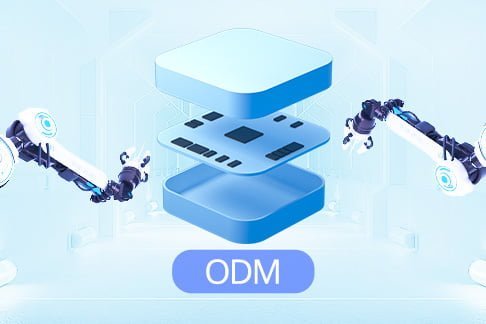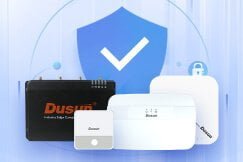

Dusun IoT’s Cellular LTE 4G gateways provide secure and reliable 2-way communication on the world’s leading cellular networks. LTE CAT1, CAT4, and CAT M1 avaliable for different usage scenarios. Intuitive user interface and cloud API provided for quickly deploying Cellular LTE solutions.
Cellular LTE 4G IoT gateway can serves as translating middleware between networks with different protocols. It aggregates sensor networks (maybe Zigbee/BLE/LoRa) data from the downlink and communicate with monitoring software via cellular transmission and send notifications if user-defined conditions are met or exceeded. Ideal for remote location monitoring or where the Internet isn’t available.
LTE CAT4 is the most common and simpler high-speed LTE UE category that supports uplink data rates up to 50Mbps and downlink data rates up to 150Mbps which enables applications like high-quality video surveillance, Cellular LTE routers, etc. To provide this performance, the LTE CAT4 utilizes the simplest MIMO configuration: the 2×2 MIMO(2 TX antennas and 2 RX antennas). Therefore, LTE CAT 4 gateway is best suited for IoT applications which require higher throughputs and more bandwidth.
LTE CAT1 is an LTE UE Category specifically designed for Machine-to-Machine(M2M) and IoT applications. In order to save power and cost for large-scale or long-range IoT system, bandwidth and communication demand is decreased. LTE CAT1 supports a maximum of 10 Mbit/s downlink speed and 5 Mbit/s uplinks. Therefore, LTE CAT 1 gateway is best suited for use cases that are dependent on both high-speed data transmission and the reliability of the 4G network.
LTE CAT M gateways and routers have significant advantages for the cellular network, IoT developers, and customers. In addition to its ability to manage low to medium data transfers, including voice-over IP and firmware and software updates, LTE-M has another significant advantage that LTE-M is backward compatible with existing LTE networks, which means carriers do not need to spend money to create the new station. Thanks to its Low power consumption capability, it enables maintenance costs to decrease drastically compared to other cellular connectivity options.

Designed for IoT developers to customize the firmware logics, and build the custom firmware from the bottom layer. A Linux-based operating system that allows developers to create their own applications and UI interfaces.

Product certifications: BQB, FCC, IC, FAC, WPC, KC, NTC, RCM, and SRRC.
Carrier Network Certification: PTCRB, GCF, AT&T, Vodafone, China Mobile, China Telecom

Multi-protocol supported: LTE, Wi-Fi, Zigbee 3.0, BLE, Lorawan, Modbus, BACnet etc.

Full Customization with ODM, capable for Application Development.

Secure device connections and data with mutual authentication and end-to-end encryption.

Deep indoor and outdoor coverage, encompass multi-floor buildings and long-range field scopes.
Our LTE Gateway is specifically suitable for healthcare scenarios.
In addition to providing multiple frequency ranges with low latency and a higher data rate, it is capable of exchanging information in a more secure approach.
As smart electric and water meters become more popular, utility providers can use cellular gateway to track water and electric use in businesses, apartments, and homes. Companies can achieve remote management based on water and electricity use, time of day, or reward households and enterprises for conserving resources.
Dusun LTE-M IoT Gateways support AT&T LTE-M as well as Zigbee 3.0, BLE, and LoRa.
Our agriculture solution reduces environmental impact, maximizes yield, and reduces costs by analyzing sensor data.
A cellular router transmits data packets between computer networks. Every piece of data has an internet protocol (IP) address, which the routers read before sending it on its journey. Some routers link the internet to smaller wide area networks (WAN) or local area networks (LAN). Explore DSGW-023 Cellular LTE router here.
In contrast to a cellular router, the cellular gateway typically connects to a network and serves entirely distinct functions. The most crucial role of a cellular gateway is protocol translation, which the gateway does as a converter, converting data from one protocol to another.
LTE supposedly has download and upload speeds of up to 300 Mbps, as opposed to 4G’s 100 Mbps. Faster data transmission and reception between IoT devices is now possible, which is essential for real-time data processing applications like remote monitoring and control. You can view more 4G vs LTE details here.
LTE was created by the Third Generation Partnership Project (3GPP). Although the specification is sometimes branded as 4G LTE, it was not initially compatible with actual 4G. In its first definition, the International Telecommunication Union (ITU) described 4G as a cellular standard that would offer stationary users data rates of 1 Gbps and mobile users rates of 100 Mbps. The ITU changed their stance in December 2010, incorporating 4G into LTE as well as several other wireless technologies.
In comparison to third-generation (3G) technology, LTE (Long-Term Evolution) increases network capacity and speed for cellphones and other cellular devices. LTE offered faster peak data rates, higher efficiency than the preceding 3G version, and more flexibility in bandwidth and frequency.
Private LTE networks are wireless networks that are using a portion of the permitted radio spectrum and are privately owned and maintained. Private LTE networks obtain secure private access from a mobile operator and employ Long Term Evolution (LTE), which includes cellular networking equipment and devices to run a standalone cellular network.
By utilizing the same mobile network as smartphones, Cellular IoT links real-world things to the internet. It uses the already-existing Cellular infrastructure to provide connection for a range of IoT applications and devices. Cellular IoT offers internet connectivity and data sharing between devices without relying on Wi-Fi or conventional connections.
Industrial Cellular gateway is made for critical infrastructure and industrial applications with Modbus serial and Ethernet connectivity. It is frequently used as wireless failover to stop network disruptions to numerous remotely fixed assets that need dependable, always-on communication. With Global Cellular LTE, it’s simple to connect and simple to develop high-performance long-distance network applications.
Industrial LTE gateways are crucial for IoT deployments, M2M communications, and SCADA connectivity. It offers a safe and dependable link to smart grid assets, industrial PLC controllers, and process automation equipment at remote or third-party sites. A secondary platform for development, such as Python or other programming languages, as well as the I/O interface are frequently provided to users. While this is going on, an industrial LTE gateway that integrates with IoT clouds like Azure or AWS offers businesses a full IoT-based Industry 4.0 solution, including data collection from field devices and transmission to the cloud for additional analysis.
The outdoor LoRa 4G gateway is unquestionably a strong option for remote environment monitoring because it allows for transparent data transmission from the device to the cloud while gathering varied environmental data scattered over various long-range locations.
The ability to monitor various IO devices, collect data on temperature and humidity, illumination intensity, CO2, wind direction and speed, and soil condition, is made possible by LoRa modulation technology. On the other hand, LoRa was created as a low-power and low-cost technology and is only compatible with Internet of Things (IoT) devices that require the best possible battery life.
PoE power supplies with battery backup and 4G backhaul for ethernet fail-over enable long-distance data transmission, maximum network availability, and lowest total-cost-of-ownership (TCO) through expedited deployment and maintenance features for tough remote outdoor environments.
NB-IoT is a type of technology utilized in 4G and 5G IoT gateways. Narrow Bandwidth-Internet of Things is what this term stands for. This is so because NB-IoT only employs a single, 200 kHz wide, restricted band of bandwidth. Explore Cat NB IoT gateway here.
The term “Long-Term Evolution for Machines” (LTE-M) refers to a type of wireless technology that is particularly well suited for low-power devices. Due to its 1 Mbps upload and download rates and a 50–100 ms latency, LTE-M is a good choice for voice data transfers.
NB-IoT is typically utilized for low-data-requirement projects like sensors and on/off switches. Higher bandwidth communications, such as Voice Over IP services, can be supported by LTE-M specifications. You can view more detailed discussion on NB-IoT vs LTE-M here.
| Cookie | Duration | Description |
|---|---|---|
| cookielawinfo-checkbox-analytics | 11 months | This cookie is set by GDPR Cookie Consent plugin. The cookie is used to store the user consent for the cookies in the category "Analytics". |
| cookielawinfo-checkbox-functional | 11 months | The cookie is set by GDPR cookie consent to record the user consent for the cookies in the category "Functional". |
| cookielawinfo-checkbox-necessary | 11 months | This cookie is set by GDPR Cookie Consent plugin. The cookies is used to store the user consent for the cookies in the category "Necessary". |
| cookielawinfo-checkbox-others | 11 months | This cookie is set by GDPR Cookie Consent plugin. The cookie is used to store the user consent for the cookies in the category "Other. |
| cookielawinfo-checkbox-performance | 11 months | This cookie is set by GDPR Cookie Consent plugin. The cookie is used to store the user consent for the cookies in the category "Performance". |
| viewed_cookie_policy | 11 months | The cookie is set by the GDPR Cookie Consent plugin and is used to store whether or not user has consented to the use of cookies. It does not store any personal data. |

